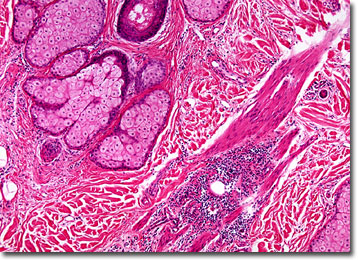Brightfield Microscopy Digital Image Gallery
Bald Scalp
The scalp is the specialized patch of skin on the human head that is typically covered profusely in hair, containing as many as 150,000 follicles at any given time. However, genetic disposition as well as a wide array of illnesses and disorders may cause hair loss, also known as alopecia.

View an image of the bald scalp section at 20x magnification.
Three different layers comprise the human scalp: the occipitofrontalis muscle that stretches from the eyebrows to the back of the head, an overlying layer of blood vessels and tissue, and an outer layer of skin. Indeed, in most ways the integument of the scalp is similar to that found in other locations of the body. The scalp does, however, contain a particularly large number of blood vessels, which means that injuries to the scalp can often lead to serious blood loss. Yet, even victims of scalping, were capable of surviving the ordeal.
The primary cause of baldness is a genetic disposition that typically leads to the receding of the hairline at the front of the head or the thinning of the hair along the crown. Though this hereditary condition is usually referred to as male pattern baldness, women may also carry the trait. Yet, females are not as susceptible to the physical manifestation of the genetic disposition because it is usually only exhibited in the presence of the male sex hormone testosterone. Male pattern baldness is considered a permanent form of hair loss, although some drugs, such as finasteride and minoxidil, have been developed that slow or stop the progression of balding in some subjects and helps stimulate new growth in a much smaller number of cases.
BACK TO THE BRIGHTFIELD MICROSCOPY IMAGE GALLERY
